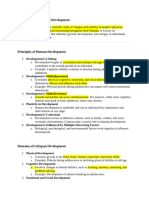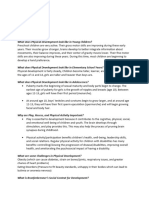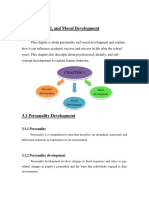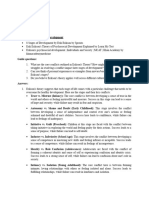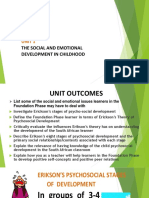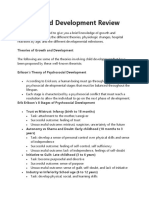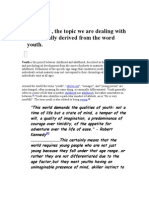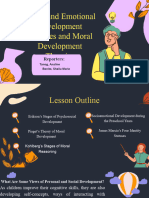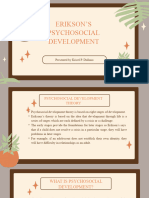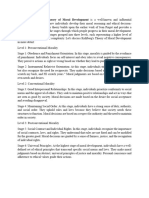0 ratings0% found this document useful (0 votes)
14 viewsFreuds Theory
Freuds Theory
Uploaded by
Baden BueFreud's psychosexual theory proposed that human development occurs in stages focused on different erogenous zones, each with associated conflicts. Key stages included the oral, anal, phallic, latency, and genital stages. Erikson's psychosocial theory also outlined stages of development across the lifespan, but focused on social and cultural influences. Erikson identified 8 stages from infancy to late adulthood, each involving a central conflict between two opposing outcomes that impact identity and psychological well-being. Both theories have been influential but also faced criticism regarding reliance on unconscious concepts and determinism.
Copyright:
© All Rights Reserved
Available Formats
Download as PPTX, PDF, TXT or read online from Scribd
Freuds Theory
Freuds Theory
Uploaded by
Baden Bue0 ratings0% found this document useful (0 votes)
14 views18 pagesFreud's psychosexual theory proposed that human development occurs in stages focused on different erogenous zones, each with associated conflicts. Key stages included the oral, anal, phallic, latency, and genital stages. Erikson's psychosocial theory also outlined stages of development across the lifespan, but focused on social and cultural influences. Erikson identified 8 stages from infancy to late adulthood, each involving a central conflict between two opposing outcomes that impact identity and psychological well-being. Both theories have been influential but also faced criticism regarding reliance on unconscious concepts and determinism.
Original Description:
Pedagogy lecture
Original Title
Freuds Theory (1)
Copyright
© © All Rights Reserved
Available Formats
PPTX, PDF, TXT or read online from Scribd
Share this document
Did you find this document useful?
Is this content inappropriate?
Freud's psychosexual theory proposed that human development occurs in stages focused on different erogenous zones, each with associated conflicts. Key stages included the oral, anal, phallic, latency, and genital stages. Erikson's psychosocial theory also outlined stages of development across the lifespan, but focused on social and cultural influences. Erikson identified 8 stages from infancy to late adulthood, each involving a central conflict between two opposing outcomes that impact identity and psychological well-being. Both theories have been influential but also faced criticism regarding reliance on unconscious concepts and determinism.
Copyright:
© All Rights Reserved
Available Formats
Download as PPTX, PDF, TXT or read online from Scribd
Download as pptx, pdf, or txt
0 ratings0% found this document useful (0 votes)
14 views18 pagesFreuds Theory
Freuds Theory
Uploaded by
Baden BueFreud's psychosexual theory proposed that human development occurs in stages focused on different erogenous zones, each with associated conflicts. Key stages included the oral, anal, phallic, latency, and genital stages. Erikson's psychosocial theory also outlined stages of development across the lifespan, but focused on social and cultural influences. Erikson identified 8 stages from infancy to late adulthood, each involving a central conflict between two opposing outcomes that impact identity and psychological well-being. Both theories have been influential but also faced criticism regarding reliance on unconscious concepts and determinism.
Copyright:
© All Rights Reserved
Available Formats
Download as PPTX, PDF, TXT or read online from Scribd
Download as pptx, pdf, or txt
You are on page 1of 18
Frued’s and Erikson’s
ERICSON OLARIO ALIETO
Doctor of Philosophy in Applied Linguistics
PROFESSOR II
Western Mindanao State University
ericson.alieto@wmsu.edu.ph
Sigmund Freud's Psychosexual Developmental Theory is a
foundational framework in psychology that proposes that human
development occurs in stages, each characterized by a focus on
different erogenous zones and associated conflicts. These stages
are crucial in shaping an individual's personality and behavior.
Oral Stage (0-1 year):
• Focus: Mouth and oral activities (sucking, biting).
• Key Conflict: Weaning from breastfeeding or bottle-feeding.
• Outcomes:
• Fixation: Oral-dependent personality traits (e.g., dependence, oral
fixation).
• Resolution: Successful resolution leads to the development of trust
and the ability to form secure relationships.
Anal Stage (1-3 years):
• Focus: Anus and control over bowel movements.
• Key Conflict: Toilet training and control over elimination.
• Outcomes:
• Fixation: Anal-retentive or anal-expulsive personality traits (e.g.,
orderliness or messiness).
• Resolution: Successful resolution leads to the development of self-
control and a sense of order
Phallic Stage (3-6 years):
• Focus: Genitals and exploration of one's own body.
• Key Conflict: Oedipus (boys) and Electra (girls) complexes, involving
sexual attraction to the opposite-sex parent and rivalry with the same-
sex parent.
• Outcomes:
• Fixation: Phallic personality traits, such as vanity, jealousy, or
competitiveness.
• Resolution: Successful resolution involves identifying with the same-sex
parent and developing a healthy gender identity.
Latency Stage (6-12 years):
• Focus: Sexual impulses are dormant.
• Key Characteristics: Focus on social and cognitive
development, friendships, and learning.
• Outcomes: The resolution of earlier conflicts allows for healthy
psychological development and the acquisition of social skills.
Genital Stage (Adolescence-Adulthood):
• Focus: Genitals and mature sexual relationships.
• Key Conflict: Reawakening of sexual desires and the pursuit of
romantic and sexual relationships.
• Outcomes:
• Fixation: Successful resolution leads to the ability to form healthy,
mature relationships.
• Failure to resolve conflicts may result in difficulties in forming
intimate relationships.
It's important to note that Freud's theory has faced criticism and
has been largely replaced by more contemporary theories of
development. Critics argue that it relies heavily on unconscious
and unverifiable concepts, and it places too much emphasis on
early childhood experiences as determinants of personality.
Nonetheless, Freud's ideas have had a lasting impact on
psychology and continue to be influential in the field of
psychoanalysis.
Erik Erikson's Psychosocial Developmental Theory
is a comprehensive framework that outlines the stages of human
development across the lifespan. Unlike Freud's psychosexual
theory, Erikson's theory focuses on the psychosocial aspects of
development, emphasizing the social and cultural influences on a
person's identity and the challenges individuals face at different
stages of life. Erikson identified eight stages of psychosocial
development, each associated with a specific conflict or crisis that
individuals must navigate to achieve healthy development.
Trust vs. Mistrust (Infancy, 0-1 year):
• Central Conflict: Establishing trust in the world through
consistent and reliable caregiving.
• Positive Outcome: Trust and confidence in others and the
world.
• Negative Outcome: Mistrust, fear, and insecurity.
Autonomy vs. Shame and Doubt (Early Childhood, 1-3
years):
• Central Conflict: Developing a sense of independence and
autonomy while learning to control bodily functions.
• Positive Outcome: Autonomy, self-confidence, and the ability
to make choices.
• Negative Outcome: Shame, doubt, and a lack of self-esteem.
Initiative vs. Guilt (Preschool, 3-6 years):
• Central Conflict: Exploring the environment and taking on new
challenges, while learning to manage impulses and guilt.
• Positive Outcome: Initiative, a sense of purpose, and the ability
to set and pursue goals.
• Negative Outcome: Guilt, inhibition, and fear of taking risks.
Industry vs. Inferiority (Elementary School, 6-12 years):
• Central Conflict: Developing competence in social, academic,
and extracurricular activities.
• Positive Outcome: Industry, a sense of accomplishment, and
self-esteem.
• Negative Outcome: Inferiority, feelings of inadequacy and low
self-esteem.
Identity vs. Role Confusion (Adolescence, 12-18 years):
• Central Conflict: Forming a clear sense of self, identity, and
purpose.
• Positive Outcome: Identity, a strong sense of self, and the
ability to make long-term commitments.
• Negative Outcome: Role confusion, identity crisis, and
uncertainty about one's place in the world.
Intimacy vs. Isolation (Young Adulthood, 18-40 years):
• Central Conflict: Establishing deep and meaningful
relationships with others.
• Positive Outcome: Intimacy, love, and lasting relationships.
• Negative Outcome: Isolation, loneliness, and difficulty forming
close connections.
Generativity vs. Stagnation (Middle Adulthood, 40-65 years):
• Central Conflict: Contributing to the well-being of future
generations through work, parenthood, and community
involvement.
• Positive Outcome: Generativity, a sense of purpose, and a
lasting legacy.
• Negative Outcome: Stagnation, feelings of unproductiveness
and dissatisfaction.
Integrity vs. Despair (Late Adulthood, 65+ years):
• Central Conflict: Reflecting on life and accepting its meaning
and value.
• Positive Outcome: Integrity, wisdom, and a sense of
fulfillment.
• Negative Outcome: Despair, regret, and bitterness.
Erikson's theory emphasizes that successful resolution of each
stage's conflict contributes to healthy psychological development
and the ability to progress to the next stage with a well-formed
identity and a positive outlook on life. However, unresolved
conflicts can lead to developmental challenges and hinder
psychological well-being. Erikson's theory has been influential in
understanding human development and identity formation
throughout the lifespan.
You might also like
- Theory of EricksonDocument26 pagesTheory of EricksonИаснеех ГаякаNo ratings yet
- Theories of Development (Lecture 2)Document20 pagesTheories of Development (Lecture 2)Syeda Nowaf Zahra NaqviNo ratings yet
- PsychologyDocument16 pagesPsychologynaomiNo ratings yet
- Erickson's Theory of Psychosocial DevelopmentDocument16 pagesErickson's Theory of Psychosocial Developmentjuljuliemer100% (3)
- Colloquium Written ExamDocument20 pagesColloquium Written ExamJihad AllamNo ratings yet
- Erikson's Psychosocial DevelopmentDocument38 pagesErikson's Psychosocial DevelopmentAmeil OrindayNo ratings yet
- Identity and PersonalityDocument14 pagesIdentity and PersonalityCherry Grace Articulo DabuconNo ratings yet
- Psychosocial Development (4)Document24 pagesPsychosocial Development (4)omarataba2003No ratings yet
- dev psy unit 1Document19 pagesdev psy unit 1Stuti KadiyalaNo ratings yet
- 1122Document8 pages1122claridyltolete1814No ratings yet
- BTVED Compilations of LessonsDocument96 pagesBTVED Compilations of Lessonssamantha albanoNo ratings yet
- Human Growth and DevelopmentDocument3 pagesHuman Growth and Developmentnicoleasabea.asanteNo ratings yet
- Infancy: Trust vs. Mistrust (0 To 1 Year)Document5 pagesInfancy: Trust vs. Mistrust (0 To 1 Year)karyl lynNo ratings yet
- Behavioural Science AssignmentDocument6 pagesBehavioural Science AssignmentERIC KIMATHI KAMUNDINo ratings yet
- Felicity Eric EriksonDocument4 pagesFelicity Eric EriksonFelicity MarieNo ratings yet
- theoriesofDocument89 pagestheoriesofsachin sharmaNo ratings yet
- Erik Eriksons TheoryDocument6 pagesErik Eriksons TheoryLoyla LangitNo ratings yet
- Development Stages in Middle and Late AdolescenceDocument21 pagesDevelopment Stages in Middle and Late AdolescenceJuju ZenemijNo ratings yet
- Psychological PerspectivesDocument28 pagesPsychological PerspectivesmabborangjanineNo ratings yet
- DR - Harpal Kaur Aujla (Associate Professor) Akal College of Education, Mastuana Sahib Sangrur (Punjab)Document20 pagesDR - Harpal Kaur Aujla (Associate Professor) Akal College of Education, Mastuana Sahib Sangrur (Punjab)Renalyne Andres BannitNo ratings yet
- Erik Erikson 8 Stages TFN PresentationDocument4 pagesErik Erikson 8 Stages TFN PresentationMcnurseNo ratings yet
- Module 3Document7 pagesModule 3erikalombardo8No ratings yet
- Psycho-Social Development by GSDocument12 pagesPsycho-Social Development by GSjugaadjagguNo ratings yet
- TCY Chapter 3Document17 pagesTCY Chapter 3Tan Cheng YeeNo ratings yet
- Chapter 5 PDF StudentsDocument20 pagesChapter 5 PDF StudentsJerome BangayanNo ratings yet
- Erik Erikson: The Life-Span ApproachDocument17 pagesErik Erikson: The Life-Span ApproachAnkit guptaNo ratings yet
- Erik Erikson: The Life-Span ApproachDocument17 pagesErik Erikson: The Life-Span Approachapi-25993162No ratings yet
- Task 3 - Independent Work - C de VeraDocument9 pagesTask 3 - Independent Work - C de VeraCynch YangtziNo ratings yet
- Adi Bhavya Jha - LSD AssignmentDocument6 pagesAdi Bhavya Jha - LSD Assignmentbhavya jhaNo ratings yet
- Reviewer in Personal Development 11Document15 pagesReviewer in Personal Development 11Nicole BirjNo ratings yet
- Develpomental TaskDocument4 pagesDevelpomental TaskPatricia OrtegaNo ratings yet
- Basic Concepts and Issues of Human DevtDocument23 pagesBasic Concepts and Issues of Human DevtJames Julxian OpeñaNo ratings yet
- Fcos 201Document97 pagesFcos 201joseckisecNo ratings yet
- Child Psychology and ManagementDocument94 pagesChild Psychology and ManagementJacob ThomasNo ratings yet
- Erikson's Psychosocial DevelopmentDocument2 pagesErikson's Psychosocial Developmentjadeyrana29No ratings yet
- Erickson's Theory PDFDocument19 pagesErickson's Theory PDFNatasha ShangeNo ratings yet
- Child Developmental TheoriesDocument47 pagesChild Developmental TheorieskamalaNo ratings yet
- theories-and-first-4-drugsDocument23 pagestheories-and-first-4-drugsrobellesantiadanaNo ratings yet
- PiagetEriksonMaslowStages of DevelopmentDocument4 pagesPiagetEriksonMaslowStages of Developmentsheba.shebs18No ratings yet
- Erikson's Eight Stages of Psychosocial DevelopmentDocument2 pagesErikson's Eight Stages of Psychosocial DevelopmentmilauyangurenNo ratings yet
- AKA Erik Homburger EriksonDocument34 pagesAKA Erik Homburger EriksonvinwaleedNo ratings yet
- BPCC 109Document21 pagesBPCC 109luckyhero124No ratings yet
- Self Esteem MKTG 2.1Document26 pagesSelf Esteem MKTG 2.1Michelle LopezNo ratings yet
- Erik Erikson Psychosocial Stages of DevelopmentDocument11 pagesErik Erikson Psychosocial Stages of DevelopmentMina SiradNo ratings yet
- Very LongDocument8 pagesVery Longpriyamghosh610No ratings yet
- Erik Erikson ReportDocument31 pagesErik Erikson ReportJohn Russell MoralesNo ratings yet
- PersonalityDocument14 pagesPersonalitySoumyalaha18_9997350No ratings yet
- Erik Erikson's Stages of Psychosocial DevelopmentDocument38 pagesErik Erikson's Stages of Psychosocial DevelopmentCLYTTEE MERR YANGKILINGNo ratings yet
- Growth and Development ReviewDocument9 pagesGrowth and Development ReviewYahra DatangNo ratings yet
- YouthologyDocument6 pagesYouthologyDisha ShahNo ratings yet
- Social Emotional and Moral DevelopmentDocument19 pagesSocial Emotional and Moral DevelopmentdoitulabingNo ratings yet
- Young Adulthood Presentation 1Document32 pagesYoung Adulthood Presentation 1Johan bioreNo ratings yet
- TOP1Document4 pagesTOP1kaedeharakaydenNo ratings yet
- Psychological Theories of Human Development (Freud To Erikson)Document21 pagesPsychological Theories of Human Development (Freud To Erikson)PiaElemosNo ratings yet
- TFN Final EriksonDocument15 pagesTFN Final EriksonRam RamNo ratings yet
- Erikson's 8 Stages of Psychosocial DevelopmentDocument6 pagesErikson's 8 Stages of Psychosocial DevelopmentJamesBuensalidoDellavaNo ratings yet
- Life Span Development Week 6Document17 pagesLife Span Development Week 6kpelotNo ratings yet
- Erickson Psychosocial StagesDocument35 pagesErickson Psychosocial Stagesisiderioshane2004No ratings yet
- 1-Develomental Theories Part OneDocument33 pages1-Develomental Theories Part OneTotaAl-mutairiNo ratings yet
- NameDocument4 pagesNameBaden BueNo ratings yet
- Evolution of MusicDocument2 pagesEvolution of MusicBaden BueNo ratings yet
- Poems ReflectionDocument1 pagePoems ReflectionBaden BueNo ratings yet
- Piagets TheoryDocument24 pagesPiagets TheoryBaden BueNo ratings yet
- Lawrence Kohlbergs Theory of Moral DevelopmentDocument2 pagesLawrence Kohlbergs Theory of Moral DevelopmentBaden BueNo ratings yet
- Marva Collins Was An American Educator Known For Her Innovative Teaching Methods and Her Dedication To Providing Quality Education To Disadvantaged StudentsDocument2 pagesMarva Collins Was An American Educator Known For Her Innovative Teaching Methods and Her Dedication To Providing Quality Education To Disadvantaged StudentsBaden BueNo ratings yet
- Study Material: Free Master Class SeriesDocument16 pagesStudy Material: Free Master Class SeriesRahul KatamNo ratings yet
- Feedback and Control SystemDocument7 pagesFeedback and Control SystemMax Sedric L LaylayNo ratings yet
- Heat Exchangers Sample 12Document4 pagesHeat Exchangers Sample 12Irfan SagalaNo ratings yet
- Unit 3 Opportunity Analysis (FINAL VERSIION)Document22 pagesUnit 3 Opportunity Analysis (FINAL VERSIION)gnopandaNo ratings yet
- Group - 1 3 1Document90 pagesGroup - 1 3 1Ama Serwaa YeboahNo ratings yet
- MK5102 01 - en UsDocument3 pagesMK5102 01 - en UsAdeilton CabocloNo ratings yet
- Jma 53126Document492 pagesJma 53126christos1157No ratings yet
- FIJI 2007 BanknotesDocument2 pagesFIJI 2007 BanknotesDavid SanzNo ratings yet
- Section 7-3Document11 pagesSection 7-3lehongphucworkNo ratings yet
- 2SC1815 en WM 20071101Document4 pages2SC1815 en WM 20071101Valentina MastinoNo ratings yet
- 2019 Vibraphone Jazz OkDocument2 pages2019 Vibraphone Jazz OkFrancesco NettiNo ratings yet
- Oscam How To GigaBlueDocument4 pagesOscam How To GigaBlueAnonymous 1U2FukcNo ratings yet
- Adaptation and Mitigation Strategies of Climate ChangeDocument8 pagesAdaptation and Mitigation Strategies of Climate ChangeGopal MishraNo ratings yet
- Manual Stata MultilevelDocument371 pagesManual Stata MultilevelJaime CazaNo ratings yet
- Explain User Story MappingDocument3 pagesExplain User Story MappingMadhavi LataNo ratings yet
- Application Form: Student Affairs and Development Division International Islamic University MalaysiaDocument5 pagesApplication Form: Student Affairs and Development Division International Islamic University MalaysiaUmair AlhadiNo ratings yet
- Appendix 3 - The Written DocumentDocument29 pagesAppendix 3 - The Written DocumentNaomi Liang100% (1)
- Petroleum Development Oman LLC Audit PlanDocument1 pagePetroleum Development Oman LLC Audit PlanSreekumarNo ratings yet
- 5.0 Tension-Members (1) BENG17-1Document20 pages5.0 Tension-Members (1) BENG17-1Erick Elvis ThomassNo ratings yet
- L4-Mass Balance Non-Reactive Part 2 (Recycle Bypass)Document23 pagesL4-Mass Balance Non-Reactive Part 2 (Recycle Bypass)SANG BÙI TUẤNNo ratings yet
- Neanderthals and Modern HumansDocument2 pagesNeanderthals and Modern HumansNikolay KolevNo ratings yet
- Implementing Corporate Strategy: Managing The Multi Business FirmDocument15 pagesImplementing Corporate Strategy: Managing The Multi Business FirmArjay MolinaNo ratings yet
- To Examine How Environmental Changes Affect The Health of A Watershed and To Predict The Effect of Human Activity On The WatershedDocument5 pagesTo Examine How Environmental Changes Affect The Health of A Watershed and To Predict The Effect of Human Activity On The WatershedMaya DemoryNo ratings yet
- Relativity106a Covectors Doppler EffectDocument76 pagesRelativity106a Covectors Doppler EffectKarabo LetsholoNo ratings yet
- BSBCRT511 Project Portfolio Task 2.1Document13 pagesBSBCRT511 Project Portfolio Task 2.1GilsonVenâncioNo ratings yet
- Roughan and Flecknell, 2006Document16 pagesRoughan and Flecknell, 2006Paul FlecknellNo ratings yet
- EcogunDocument11 pagesEcogunAntonioNo ratings yet
- Statistical Methods 15 Critical Appraisal: Community ProjectDocument17 pagesStatistical Methods 15 Critical Appraisal: Community ProjectTheGimhan123No ratings yet
- Petrel 2014 Quick Start GuideDocument6 pagesPetrel 2014 Quick Start GuideDavid MontoyaNo ratings yet








